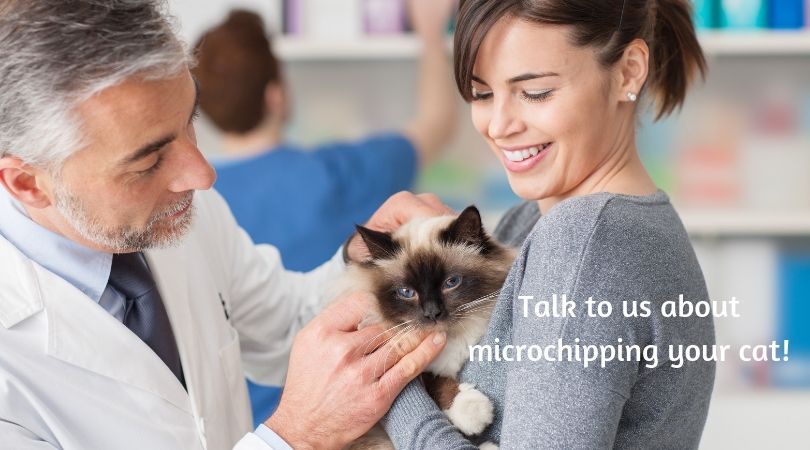National Check the Chip Day is August 15th. This important date isn’t the occasion to rummage through your pantry for stale snacks (although that’s always a good thing to do once in a while); it’s actually meant to serve as a yearly reminder to pet owners to check their pets’ microchip registrations and update any information if necessary.
While microchips can be extremely effective for identifying lost pets and reuniting them with their families, a happy reunion can’t occur if the microchip registration is incorrect – or if your pet isn’t microchipped at all! Many cat owners wonder why they should bother having their feline friends microchipped if they are indoor-only. Although you think your cat will never go outside, there are many opportunities for their curiosity to get the best of her, in which case you will definitely be glad you had your cat microchipped.
Open Doors and Windows
You may be thinking, “My indoor cat would NEVER roam outside. She doesn’t need a microchip.” But never say never! There are many exciting things that could lure (or scare) your kitty out an open door or window.
- Curiosity: You never know what could pique your cat’s interest – a particularly vocal bird, a rambunctious squirrel, or possibly another cat. Even if your cat has never attempted to jump through an open window or door before, any of these things could lead your indoor-only cat to take a leap into the great outdoors.
- Fear: If your cat is averse to meeting new people, too many strangers in your home could be what drives her to make a bolt out of a door left ajar. This can happen, for example, if you are having a party in your home. Lots of unfamiliar people + people coming in and out all day/night = the perfect chance for your cat to escape through an open door.
- Opportunity: Sometimes your cat just needs the right circumstance to make her getaway. For instance, if you are having home repairs done in your home, workers may not be aware of your cat and leave the door open for long periods of time – or even just long enough for your cat to go exploring where she shouldn’t.

Many indoor-only cats don’t wear collars or have any sort of identification tags. According to HomeAgain, a national pet recovery database, “A recent study showed that less than 2% of cats without microchips were returned home. However, if a cat is microchipped, the return-to-owner rate is 20 times higher than if the cat was not microchipped.” By microchipping your pet cat, you ensure she will always have a form of ID on her – collar or not.
Traveling
Let’s be honest: your indoor-only cat isn’t ALWAYS indoors. Whether you are taking your feline to the vet for a checkup, to the pet parlor for cat grooming, or even on a plane for extensive travel, there are multiple chances for her to escape. If kitty isn’t used to car rides, this can be a scary or over-stimulating experience, and she may react by trying to escape from the car or from your arms while walking through the parking lot. Of course, you should always keep your cat in a secure, vet-approved carrier during car rides and other transport, but microchips are an extra-added security.
In Case of Emergency
If the worst-case scenario occurs and you must leave your home in a hurry due to an emergency or disaster, you may not always have time to ensure your cat is properly transported during evacuation. If your otherwise indoor-only cat is accidentally set free during a crisis situation (fire, earthquake, hurricane, etc.), you are much more likely to be reunited with your beloved pet if she is microchipped. There have been a number of newsworthy incidences about cats with microchips being returned to their homes, sometimes from great distances, due to their chips being scanned by veterinary clinics or animal shelters. One cat named "Grumpy Henry" was even found 150 miles from home!
Pet Theft
Although a very rare occurrence, unfortunately, pet theft does happen sometimes. While pet microchips are not tracking devices, they do provide a permanent radio frequency ID for your cat. If your cat finds herself with a new owner and is taken to a vet clinic or animal shelter (for a checkup, for instance), she should be routinely scanned for a microchip to reveal her unique ID number, and you could be contacted using the information on file with your cat's microchip. For that reason, it’s important to make sure your indoor-only cat has a microchip AND that you keep her microchip registration up to date.

Although indoor-only cats are generally safer because they aren’t exposed to diseases from animals, busy streets, predators, etc., they also aren’t familiar with life outside your home. If they get outside accidentally, they can become lost more easily and may not be wearing a collar or ID tag. Microchipping your indoor-only cat can give you peace of mind and ensure your pet is returned to you in the event she does get lost. This August 15th, you can celebrate Check the Chip Day by contacting us to get your cat microchipped and/or ensuring your registration is up to date (and toss those stale chips in the trash!).
